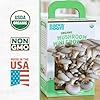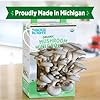Basinel Rolling Grill Basket 2-Pack,304 Stainless Steel Grill Basket with Removable Wooden Handle,BBQ Tool & Smoker Accessory for Veg & Shrimp,Ideal for Outdoor Cooking,Camping & Gifts for Dad/Husband/Men
21% OffBack to the Roots Organic Mini Mushroom Grow Kit, Harvest Gourmet Oyster Mushrooms In 10 days, Top Gardening Gift, Holiday Gift, & Unique Gift
32% OffElephant ear plants, known by their scientific name Colocasia, are stunning tropical plants grown primarily for their spectacularly large heart-shaped leaves. Their exotic foliage adds a tropical flair to indoor spaces. When cared for properly, they can grow over 5 feet tall and wide inside homes.
Below you will find a comprehensive guide on growing and caring for elephant ear houseplants, including tips on soil, lighting, watering, humidity, fertilizing, troubleshooting problems, propagation, repotting, overwintering them indoors, and the many benefits they provide.
Overview of Elephant Ear Plant Care Indoors
Caring for elephant ear plants inside takes some adjustments from their natural outdoor environment, but they can thrive indoors in the right conditions. Here is an overview of their key care needs:
- Soil – Rich, humus-y, well-draining potting mix. Keep mildly moist but not waterlogged.
- Light – Bright, indirect light or a few hours of morning/evening sun. Low light causes small leaves.
- Temperature – Warm room temperatures from 65-85°F (18-29°C). Keep above 60°F (15°C).
- Humidity – Prefers 40-50% humidity. Increase levels around the plant.
- Water – Water when top few inches of soil become dry. Don’t let sit in standing water.
- Fertilizer – Feed monthly during growth periods with a balanced liquid fertilizer.
- Pot Size – Size up the pot as the plant grows. Needs adequate room for root development.
Getting these basic care needs right is key to successfully growing these tropical beauties indoors!
Best Soil for Elephant Ear Plants
Elephant ears thrive in a rich, organic potting mix that retains some moisture but also drains well. The ideal potting soil for elephant ear houseplants includes:
- Aged compost – Provides nutrient-rich organic matter.
- Peat or coco coir – Retains moisture but leaves soil mix airy.
- Perlite or pumice – Creates air pockets for drainage.
- Worm castings (optional) – Nutrient boost.
- pH between 6.0-7.0.
A general houseplant potting soil amended with extra perlite is usually suitable. Using a pot with drainage holes is also critical to prevent soggy soil.
Proper Lighting Conditions
Elephant ear plants need abundant light to flourish indoors. Here are their light preferences:
- Bright, indirect light is essential to prevent scorching their leaves. A southern or western exposure is ideal.
- Provide 4-6 hours of morning or evening sun if possible. This encourages faster growth and larger leaves. Just ensure the leaves don’t burn.
- Low light causes small leaves and stunted growth. Rotate plant periodically to equalize growth.
- Use grow lights to supplement natural light, especially in winter. LED grow light panels work well. Place lights 6-12 inches above the plant.
Adjusting these light conditions properly is key to the plant developing large, dramatic leaves indoors.
Temperature and Humidity
Recreating a tropical environment involves getting both temperature and humidity levels right. Here are optimal levels:
- Temperature – 65-85°F (18-29°C)
- Humidity – 40-50% humidity
Keeping elephant ears too cool can impair growth and cause leaf loss. Some tips:
- Place plant out of cool drafts from windows/AC vents
- Move to warmer room in winter if needed
- Use a small humidifier nearby to increase moisture
Meeting these temperature and humidity preferences mimics their native environment.

Watering Elephant Ears Properly
Establishing the right watering routine is vital to growing healthy elephant ears indoors. They need:
- Even moisture – Allow the top several inches of soil to dry out between waterings.
- Good drainage – Water until it runs from the drainage holes. Never let sit in standing water.
- Less frequent watering in winter – Back off on water as plant goes semi-dormant.
Additional tips:
- Feel the soil or lift the pot to gauge when to water
- Water less frequently with cooler indoor temperatures
- Leaves yellowing is a sign of overwatering
- Leaves crisping is a sign of underwatering
Check moisture levels frequently until you determine the right watering schedule. Proper moisture prevents almost all cultural problems with elephant ear houseplants.
Fertilizing Recommendations
While elephant ears derive most nutrients from the rich potting soil, fertilizer is still needed for lush growth. Use a balanced liquid fertilizer during active growth periods:
- March-October – Fertilize monthly at half strength concentration.
- November-February – Discontinue fertilizer for winter dormancy period.
Look for a fertilizer with an NPK ratio like 20-20-20 or fish emulsion. Mix it into watering can per label instructions before watering. This ensures a constant supply of nutrients to feed rapid leaf growth!
Appropriate Pot Size
Providing ample room for elephant ear tubers to grow is essential for leaf development. Monitor pot size and:
- Size up pots as the plant grows. Move to a 2-3 inch larger pot when rootbound.
- Plant in wide, shallow planters versus narrow, deep pots to allow for extensive root expansion.
- Use containers with drainage holes and drain trays to prevent soggy soil. Plastic, ceramic, or glazed pots all work well.
If rootbound too long, growth will slow and leaves remain small. Repot every 2-3 years in early spring before vigorous growth resumes.
Troubleshooting Common Elephant Ear Problems
Elephant ear houseplants are generally resilient but can develop issues if cultural needs aren’t met properly. Here are solutions to common challenges:
- Yellow leaves – Overwatering – Allow soil to dry between waterings
- Drooping leaves – Underwatering – Water more frequently
- Crispy brown leaf edges – Low humidity – Mist plant or use humidifier
- Few/small leaves – Insufficient light – Provide brighter light conditions
Closely observing the plant and adjusting care as needed prevents most cultural troubles.
How to Propagate Elephant Ear Houseplants
Propagating new elephant ear plants from a mature specimen is quite straightforward. These tropical perennials produce offsets called pups or plantlets from the mother tuber that can be divided.
Follow these steps:
- Allow the plant to become root bound to encourage pup development
- Uproot the plant in spring and gently separate pups from the main tuber
- Select pups that have small roots formed and at least one leaf
- Pot the pups individually in small pots with well-draining soil
- Provide warm, bright, humid conditions as they establish
- Water when soil becomes partly dry
- New plants grow quickly so repot as needed through the season
For a continuous supply, divide vigorous growers every 2-3 years when repotting. sharing these dazzling plants!
Overwintering Elephant Ears
Elephant ears generally enter dormancy when light and temperatures decline in winter. Their growth naturally slows allowing them to be overwintered indoors until spring. Here’s how to store them:
- Cut back on water and fertilizer from October onwards as plant goes semi-dormant
- Prune back foliage as it yellows and dies off
- Dig up tuber once it’s defoliated and allow drying in indirect light for a few days
- Inspect tuber and prune any rotted bits
- Place in slightly moist peat perlite, sphagnum moss or vermiculite mix
- Store tuber in cool area around 60°F away from freezing temps
- Check every few weeks and sprinkle with water to keep mix lightly moist
- Repot in March/April to restart growth before it breaks dormancy
Stored properly in this state of hibernation, elephant ear tubers will retain enough energy to re-leaf the following season.
Benefits of Growing Elephant Ear Houseplants
Beyond being gorgeous ornamental specimen plants, elephant ears offer many benefits. As vibrant additions to indoor spaces, they provide:
- Visual interest – Their huge, vibrant leaves garner attention. The various varieties offer colorful selections beyond basic green.
- Tropical look – The large leaves bring a tropical look, reminiscent of a Hawaiian landscape, to any indoor space.
- Clean air – As efficient photosynthesizers, they filter indoor air pollutants and release oxygen.
- Humidity boost – Their large transpiring leaves add soothing moisture to dry, heated indoor air.
- Low maintenance – When basic needs are met, elephant ears require little care and thrive for years.
- Multiplication – Mature plants can be divided, offering free plants to expand or share.
- Year round enjoyment – They can be overwintered inside to provide foliage year-round as houseplants.
There are myriad rewards to cultivating these spectacular super-sized leaf beauties inside!
With the proper growing conditions and care regimen, elephant ear plants can attain impressive proportions indoors. Their generous foliage contributes color, texture, tropical flair, and loads of visual impact. They quickly become dazzling focal points wherever displayed.
For indoor gardeners looking to bring the tropics indoors and make a bold statement, elephant ear plants perfectly fit the bill!




























